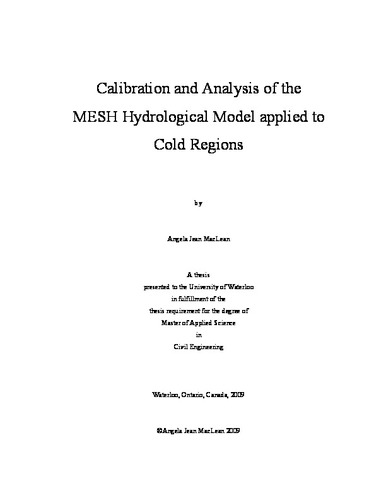| dc.contributor.author | MacLean, Angela | |
| dc.date.accessioned | 2009-09-30 20:57:33 (GMT) | |
| dc.date.available | 2009-09-30 20:57:33 (GMT) | |
| dc.date.issued | 2009-09-30T20:57:33Z | |
| dc.date.submitted | 2009-09-30 | |
| dc.identifier.uri | http://hdl.handle.net/10012/4767 | |
| dc.description.abstract | Concerns regarding climate change have brought about an increased interest in cold region hydrology, leading to the formation of the IP3 research network. This work is part of the IP3 Network, which has the overall goal to evaluate and demonstrate improved predictions of hydrological and atmospheric fields for cold regions. As such this thesis involves a series of calibration and validation experiments on the MESH hydrological model (used by IP3 for predictions) with two cold region case studies. The first case study is the very well instrumented Reynolds Creek Experimental Watershed in Idaho, USA and the second case study is the Wolf Creek watershed in the Yukon Territory. As the MESH model is still in the development phase, a critical component of model development is a thorough analysis of model setup and performance. One intention of this research is to provide feedback for future development of the MESH hydrological model.
The Reynolds Creek site was modeled as part of this thesis work. This site was chosen based on the long term, highly distributed and detailed data set. The second site, Wolf Creek, was used for a simplified case study. Models of both case study sites were calibrated and validated to carefully evaluate model performance. Reynolds Creek was calibrated as a single objective problem as well as multi-objective problem using snow water equivalent data and streamflow data for multiple sites.
The hydrological simulations for Wolf Creek were fair; further calibration effort and a more detailed examination of the model setup would have likely produced better results. Calibration and validation of Reynolds Creek produced very good results for streamflow and snow water equivalent at multiple sites though out the watershed.
Calibrating streamflow generated a very different optimal parameter set compared to calibrating snow water equivalent or calibrating to both snow water equivalent and streamflow in a multi-objective framework. A weighted average multi-objective approach for simultaneously calibrating to snow water equivalent and streamflow can be effective as it yields a reasonable solution that improves the single objective snow water equivalent results without degrading the single objective streamflow results. | en |
| dc.language.iso | en | en |
| dc.publisher | University of Waterloo | en |
| dc.subject | Hydrological Modeling | en |
| dc.subject | Automatic calibration | en |
| dc.title | Calibration and Analysis of the MESH Hydrological Model applied to Cold Regions | en |
| dc.type | Master Thesis | en |
| dc.pending | false | en |
| dc.subject.program | Civil Engineering | en |
| uws-etd.degree.department | Civil and Environmental Engineering | en |
| uws-etd.degree | Master of Applied Science | en |
| uws.typeOfResource | Text | en |
| uws.peerReviewStatus | Unreviewed | en |
| uws.scholarLevel | Graduate | en |

